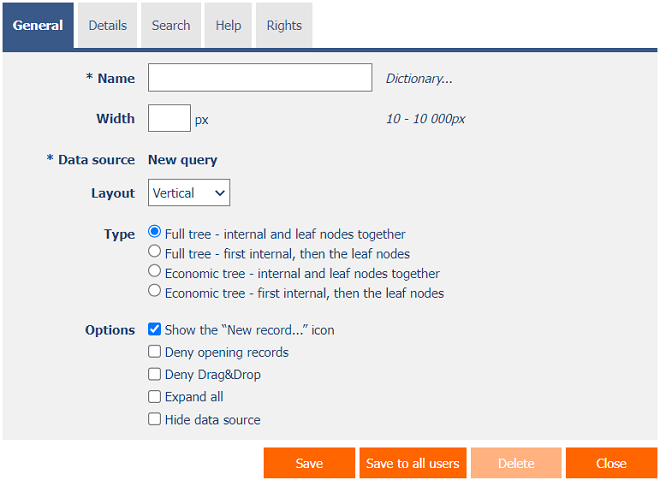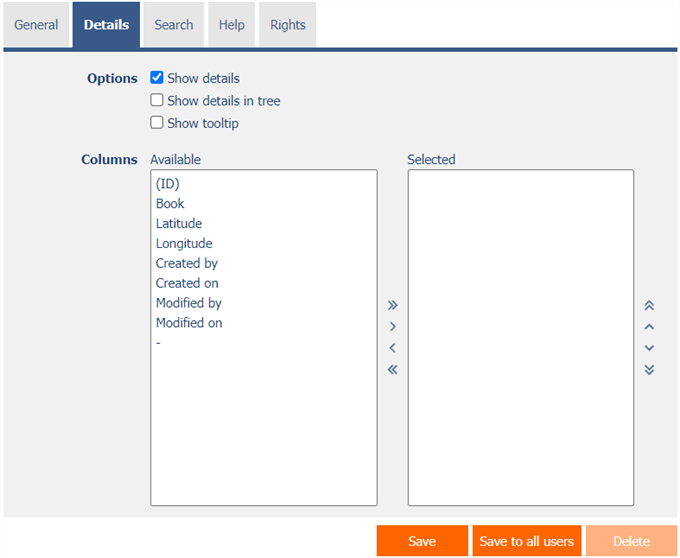Manual in PDF format
1. Basic information
1.1. Description of the control
Tree is a tree structure.
1.2. Create a new control
A new tree can be created as follows from the edit form using the toolbar with controls:
- First, the position in which the new tree is to be placed is determined by clicking the mouse in the edit form. This will highlight the selected position with a gray horizontal line. Then just click on the “Tree” item in the toolbar of the edit form, fill in the attributes of the new control in the newly opened dialog, and then save. This will insert a new tree in the pre-selected location of the edit form.
- If the desired position is not determined before inserting a new tree, the new tree will be inserted at the end of the edit form.
1.3. Edit or delete a control
- For each existing control, a pencil icon appears on the left side of the edit form to change or delete the control's settings.
- Individual controls can be moved vertically in the edit form using the Drag&Drop method. Moving consists of grabbing the control, preferably after its name located in the left column of the edit form, and then dragging it to the desired place in the edit form.
- For safety reasons, it is important to have the function of moving controls enabled using the “Drag&Drop” check box located above the toolbar with controls. This field is unchecked each time you log in to the application.
2. List of tabs in the control settings dialog
- General – Setting general properties
- Details – Settings for columns displayed in details
- Search – Search settings
- Help – Help text settings
- Rights – Rights settings
2.1. “General” tab

2.1.1. Name
- The name of the control displayed in the header of the tree structure.
2.1.2. Dictionary
- The dictionary displays a list of names of other controls, forms, view pages, categories, applications, and application groups used throughout the application.
- The dictionary search is used to design the correct control name and to maintain the consistency of the nomenclature throughout the application so that controls with the same meaning located in different places in the application are named in the same way.
2.1.3. Width
- The width of the control, expressed in pixels.
- If this input field is not filled in, the width of the tree structure will be determined automatically by the web browser.
2.1.4. Data source
- The data source defines the source database records displayed in a tree structure.
- Data source settings are made in the graphical designer of database queries. A detailed description of the database query designer is provided in the separate “Database Query Designer” guide.
2.1.5. Layout
- The layout determines how the tree structure is displayed, either from left to right or from top to bottom.
- The drop-down list contains the following values:
- Horizontal – displaying the tree structure from left to right
- Vertical – top-down display of the tree structure
2.1.6. Type
- The tree type determines the display range of the tree structure.
- The whole tree contains all nodes, and the subsequent showing or hiding of individual subnodes is solved using javascript.
- The power saving mode shows only active nodes, and the subsequent showing or hiding of individual subnodes is solved by updating the web page.
- The drop-down list contains the following values:
- Full tree – internal and leaf nodes together
- Full tree – first internal, then the leaf nodes
- Economic tree – internal and leaf nodes together
- Economic tree – first internal, then the leaf nodes
2.1.7. Options
- Show “New Record…” icon
- Checking this box determines whether an icon should be displayed in the header of the tree structure and for individual nodes, which redirects the user to a specific edit form in order to create a new record in the database.
- Deny opening records
- Checking this box determines whether all users should be denied access to the edit form to open the displayed database record using the pencil icon that appears at the beginning of each node in the tree.
- Deny Drag&Drop
- Checking this box determines whether dragging and dropping of individual nodes in the tree structure should be disabled.
- Expand all
- Checking this box determines whether the tree structure should be fully expanded, including all its nodes and subnodes, when it is displayed.
- An icon for expanding the entire tree structure is also available in the footer of each tree structure.
- Hide data source
- Checking this box determines whether the contents of the tree structure should be automatically hidden when the edit form is opened. Database records will not be displayed to the user until the “View” icon is clicked or clicking on the tab in which the tree structure is located.
2.2. “Details” tab

2.2.1. Options
- Show details
- Checking this box determines whether the tree structure should display the details of each record to the right of the tree structure.
- Show details in the tree
- Checking this box determines whether the tree structure should display the details of individual records as part of individual nodes or subnodes.
- Show tooltip
- Checking this box determines whether the tree structure should display the details of individual records in the tooltip when the mouse hovers over individual records.
2.2.2. Columns
- Definition of columns of details displayed to the right next to the tree structure in details, or when hovering the mouse over individual records of the tree structure.
2.3. “Search” tab

2.3.1. Options
- Activate search
- Checking this box determines whether a row with a search box and a “Search” button should be automatically displayed in the tree header.
- Show search results only
- Checking this box determines whether the data in the tree structure should be displayed only when filling in the values in the form referenced by the constraints of the database query of this tree structure.
2.4. “Help” tab

2.4.1. Help
- Help is the text displayed in the tooltip after clicking on the question mark icon, which is located in the header of the tree structure.
- Help text supports simple text formatting using wiki syntax:
- '''Bold text'''
- ''Italics''
- '''''Bold italics'''''
- ""Text enclosed in double quotes""
- Lists:
- * Heading 1
- ** Subheading 1.1
- ** Subheading 1.2
- * Heading 2
- * Heading 3
- # Numbered heading 1
- ## Numbered subheading 1.1
- ## Numbered subheading 1.2
- # Numbered heading 2
- # Numbered heading 3
- The help radio button contains the following two types of help definitions:
- Text – help text defines a manually entered text string located in a multi-line text field below the radio button
- From query – the help text defines the result of a database query, which is evaluated when opening the edit form
2.5. “Rights” tab

2.5.1. Rights
- Rights define a list of user groups and users who have permission to view the control on the edit form.
2.5.2. Replace rights to other controls
- The “Replace rights to other controls” function is used to unify the rights within the entire edit form for controls that are related in terms of rights.
- Thanks to the “Show…” link, it is possible to display a list of all controls in the edit form, including setting the rights of these controls. For each control, a check box is displayed that allows you to select the control. When saving a control, the same rights are then set for these selected controls.
- An alternative for unifying rights within the entire edit form is to display the report available from the “Subordinate object rights” tab in the edit form settings.
